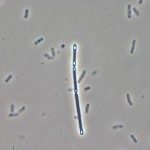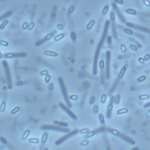Link to Pubmed [PMID] – 9033408
Biochemistry 1997 Feb;36(5):1163-72
The proteins encoded by the fructose-inducible lev operon of Bacillus subtilis are components of a phosphotransferase system. They transport fructose by a mechanism which couples sugar uptake and phosphoenolpyruvate-dependent sugar phosphorylation. The complex transport system consists of two integral membrane proteins (LevF and LevG) and two soluble, hydrophilic proteins (LevD and LevE). The two soluble proteins from together with the general proteins of the phosphotransferase system, enzyme I and HPr, a protein phosphorylation chain which serves to phosphorylate fructose transported by LevF and LevG. We have synthesized modified LevD and LevE by fusing a His-tag to the N-terminus of each protein allowing rapid and efficient purification of the proteins. We determined His-9 in LevD and His-15 in LevE as the sites of PEP-dependent phosphorylation by isolating single, labeled peptides derived from 32P-labeled LevD, LevD(His)6, and LevE(His)6. The labeled peptides were subsequently analyzed by amino acid sequencing and mass spectroscopy. Mutations replacing the phosphorylatable histidyl residue in LevD with an alanyl residue and in LevE with a glutamate or aspartate were introduced in the levD and levE genes. These mutations caused strongly reduced fructose uptake via the lev-PTS. The mutant proteins were synthesized with a N-terminal His-tag and purified. Mutant LevD(His)6 was very slowly phosphorylated, whereas mutant LevE(His)6 was not phosphorylated at all. The corresponding levD and levE alleles were incorporated into the chromosome of a B. subtilis strain expressing the lacZ gene under control of the lev promoter. The mutations affecting the site of phosphorylation in either LevD or LevE were found to cause constitutive expression from the lev promoter of B. subtilis.

